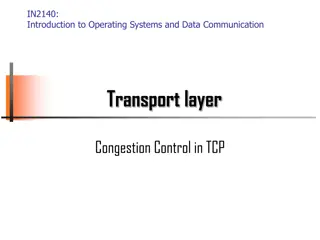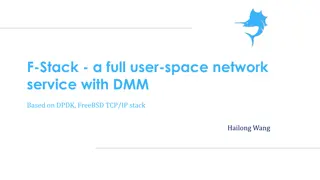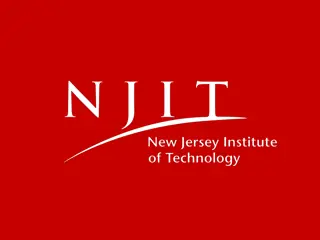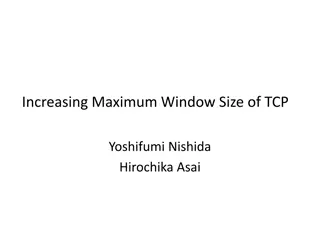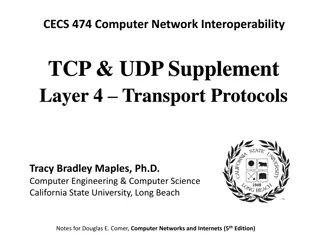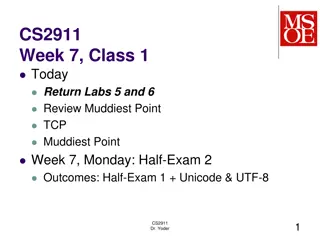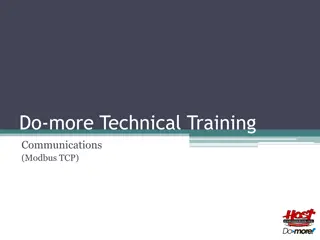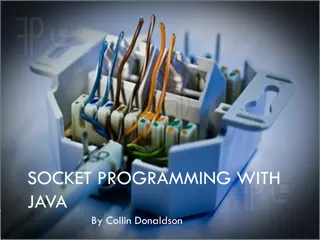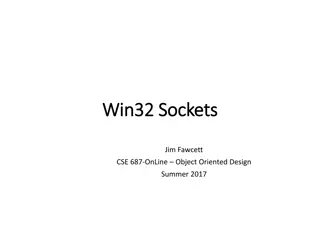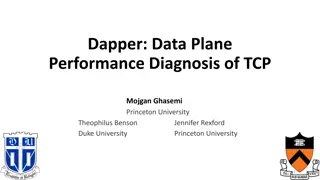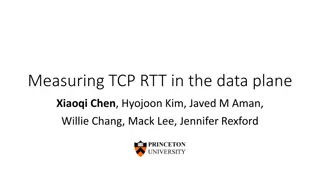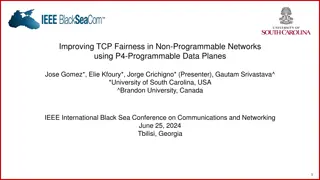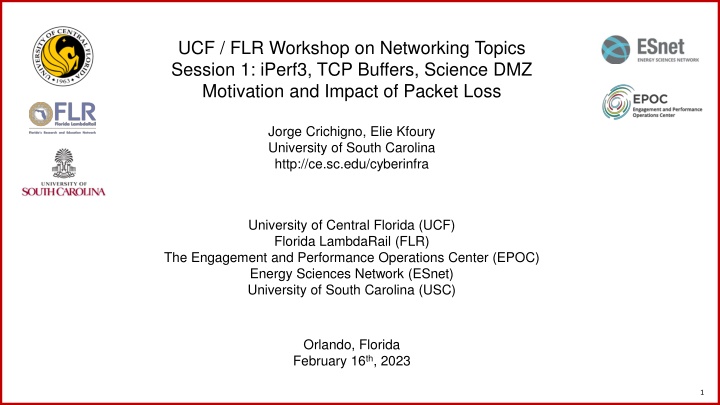
Advanced Networking Workshop: iPerf3, TCP Buffers, Science DMZ
Enhance your networking knowledge with the UCF/FLR Workshop on Networking Topics covering iPerf3, TCP Buffers, and Science DMZ. Explore the impacts of packet loss, hands-on sessions, NTP Lab Series, and more. Join experts from the University of South Carolina on February 16th, 2023, for a deep dive into network performance optimization.
Download Presentation

Please find below an Image/Link to download the presentation.
The content on the website is provided AS IS for your information and personal use only. It may not be sold, licensed, or shared on other websites without obtaining consent from the author. If you encounter any issues during the download, it is possible that the publisher has removed the file from their server.
You are allowed to download the files provided on this website for personal or commercial use, subject to the condition that they are used lawfully. All files are the property of their respective owners.
The content on the website is provided AS IS for your information and personal use only. It may not be sold, licensed, or shared on other websites without obtaining consent from the author.
E N D
Presentation Transcript
UCF / FLR Workshop on Networking Topics Session 1: iPerf3, TCP Buffers, Science DMZ Motivation and Impact of Packet Loss Jorge Crichigno, Elie Kfoury University of South Carolina http://ce.sc.edu/cyberinfra University of Central Florida (UCF) Florida LambdaRail (FLR) The Engagement and Performance Operations Center (EPOC) Energy Sciences Network (ESnet) University of South Carolina (USC) Orlando, Florida February 16th, 2023 1
Workshop on Networking Topics Webpage with PowerPoint presentations: http://ce.sc.edu/cyberinfra/workshop_2023_feb.html Hands-on sessions: to access labs for the hands-on sessions, use the following link: https://netlab.cec.sc.edu/ Username: email used for registration Password: nsf2023 2
NTP Lab Series Lab experiments Lab 1: Introduction to Mininet Lab 11: Router s Buffer Size Lab 2: Introduction to iPerf Lab 12: TCP Rate Control with Pacing Lab 3: WANs with latency, Jitter Lab 13: Impact of Maximum Segment Size on Throughput Lab 4: WANs with Packet Loss, Duplication, Corruption Lab 14: Router s Bufferbloat Lab 5: Setting WAN Bandwidth with Token Bucket Filter (TBF) Lab 15: Hardware Offloading on TCP Performance Lab 6: Traditional TCP Congestion Control (HTCP, Cubic, Reno) Lab 16: Random Early Detection Lab 7: Rate-based TCP Congestion Control (BBR) Lab 17: Stochastic Fair Queueing Lab 8: Bandwidth-delay Product and TCP Buffer Size Lab 18: Controlled Delay (CoDel) Active Queue Management Lab 9: Enhancing TCP Throughput with Parallel Streams Lab 19: Proportional Integral Controller-Enhanced (PIE) Lab 10: Measuring TCP Fairness Lab 20: Classifying TCP traffic using Hierarchical Token Bucket (HTB) 3
Organization of the Lab Manuals Each lab starts with a section Overview Objectives Lab topology Lab settings: passwords, device names Roadmap: organization of the lab Section 1 Background information of the topic being covered (e.g., fundamentals of perfSONAR) Section 1 is optional (i.e., the reader can skip this section and move to lab directions) Section 2 n Step-by-step directions 4
Mininet Mininet provides network emulation opposed to simulation, allowing all network software at any layer to be simply run as is Mininet s logical nodes can be connected into networks Nodes are sometimes called containers, or more accurately, network namespaces Containers consume sufficiently few resources that networks of over a thousand nodes have been created, running on a single laptop 5
MiniEdit MiniEdit is a simple GUI network editor for Mininet 6
MiniEdit To build Mininet s minimal topology, two hosts and one switch must be deployed 7
iPerf3 iPerf3 is a real-time network throughput measurement tool It is an open source, cross-platform client-server application that can be used to measure the throughput between the two end devices Measuring throughput is particularly useful when experiencing network bandwidth issues such as delay, packet loss, etc. 8
iPerf3 iPerf3 can operate on TCP, UDP, and SCTP, unidirectional or bidirectional way In iPerf3, the user can set client and server configurations via options and parameters iPerf3 outputs a timestamped report of the amount of data transferred and the throughput measured 9
TCP Traditional Congestion Control The principles of window-based CC were described in the 1980s1 Traditional CC algorithms follow the additive-increase multiplicative-decrease (AIMD) form of congestion control Sender Receiver Seq = 110, 10 bytes Seq = 120, 10 bytes Seq = 130, 10 bytes Seq = 140, 10 bytes Ack = 110 Packet loss Additive increase Multiplicative decrease Sending rate Out-of-order segments Triple duplicate ACK Ack = 110 Ack = 110 Time Seq = 110, 10 bytes Time 1. V. Jacobson, M. Karels, Congestion avoidance and control, ACM SIGCOMM Computer Communication Review 18 (4) (1988). 10
BBR: Model-based CC TCP Bottleneck Bandwidth and RTT (BBR) is a rate-based congestion-control algorithm1 BBR represented a disruption to the traditional CC algorithms: is not governed by AIMD control law does not the use packet loss as a signal of congestion At any time, a TCP connection has one slowest link bottleneck bandwidth (btlbw) probe Sending rate 125 Router Sender Receiver btlbw 100 75 drain Bottleneck (btlbw) Output port buffer Time cycle 1 cycle 2 ... 8 RTTs 1. N. Cardwell et al. "BBR v2, A Model-based Congestion Control." IETF 104, March 2019. 11
TCP Buffer Size In many WANs, the round-trip time (RTT) is dominated by the propagation delay To keep the sender busy while ACKs are received, the TCP buffer must be: Traditional congestion controls: TCP buffer size 2BDP BBRv1 and BBRv2: TCP buffer size must be considerable larger than 2BDP 12
Lab 7: Understanding Rate-based TCP Congestion Control (BBR) 13
Lab Goal and Topology Deploy emulated WANs in Mininet Modify the TCP congestion control algorithm in Linux using sysctl tool Compare the performance of TCP Reno and TCP BBR in high-throughput high- latency networks Without 30ms propagation delay With 30ms propagation delay Demonstrating the impact of packet loss on the throughput of TCP Lab topology: 14
Additional Slides BBR performance on FABRIC Performance measurements for a single flow, 0.0046% packet loss rate 15
Additional Slides BBR performance on FABRIC Performance measurements for a single flow, 0.0046% packet loss rate 16
BDP Bandwidth = 1Gbps RTT = 30ms BDP (bytes) = 3,750,000 bytes BDP (MB) = 3.57MB 17





